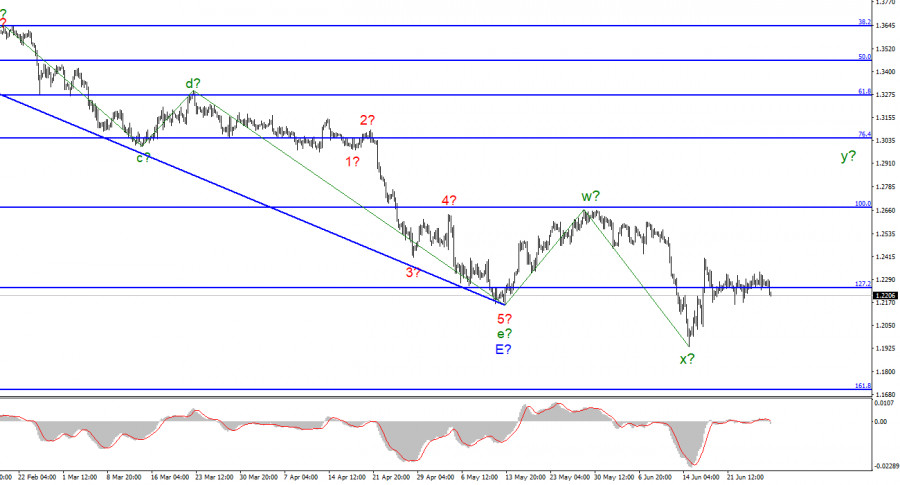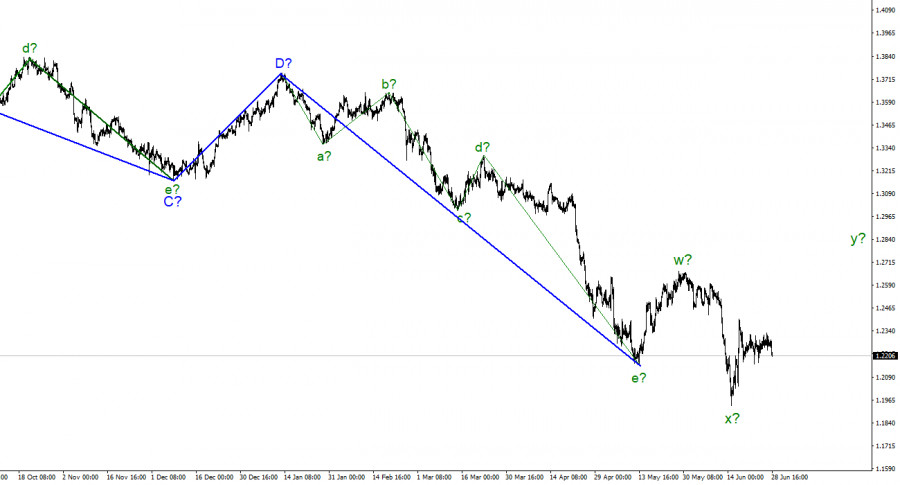
According to the pound/dollar instrument, the wave marking now requires additions and adjustments, but it may still take a more or less digestible form. At the moment, the last downward wave has gone beyond the low of the expected downward trend segment, which I consider completed. Thus, the classical correction structure a-b-c will no longer work. Nevertheless, wave analysis allows the construction of various correction structures, so a more complex three-wave formation w-x-y can be constructed. Anyway, the pound and the euro continue to show a very high degree of correlation, and both instruments should build approximately the same sections of the trend. Ascending. At the same time, according to the euro currency, it can be a classic a-b-c, and according to the pound, a rarer w-x-y. But in both cases, the instruments should now build an ascending wave, which should go beyond the peak of the previous ascending one. The wave marking on the British now looks not quite unambiguous, but still has the right to life. The fact that a stronger appreciation of the US currency did not begin after the Fed meeting is encouraging and gives so far chances to build the necessary upward wave.
Waiting for Andrew Bailey's speech and the American GDP
The exchange rate of the pound/dollar instrument decreased by 60 basis points on June 28. Market activity on Tuesday was again low. Even more surprising is the decline of the euro and the pound, although there were no prerequisites for this. I assumed that the market could react to Christine Lagarde's speeches on Monday and Tuesday, but today both euro currencies have declined, although Bailey will speak at the economic forum in Portugal only tomorrow. In other words, if the euro had specific reasons not to stand still, then the pound did not have them. Thus, I am assuming that Lagarde's speech has nothing to do with it. The market shows that it is not too interested in working out the current wave markup yet. The instrument moves strictly horizontally, along the 127.2% Fibonacci level. We also need an increase in demand for the British pound, without which there will be no construction of a corrective wave y, and adjustments will have to be made to the wave markup.
Meanwhile, tomorrow is a more interesting day than the first two this week. That's because Andrew Bailey, Christine Lagarde, and Jerome Powell will give speeches in Portugal on Wednesday. I don't believe that they will provide important information to the market since Lagarde's first two speeches have already shown exactly that. Or the market simply did not pay any attention to them. In any case, it is not the events themselves that are important to us, but how the market will work them out. And it has obvious problems with this now. Also tomorrow, a report on GDP for the first quarter in the United States will be released. According to market expectations, the US economy will decline by 1.5% q/q. However, this value has long been known, and if it does not very likely change, it is unlikely that the market will pay attention to this event.
General conclusions
The wave pattern of the pound/dollar instrument has become more evident. I still expect the construction of an upward wave within the corrective upward structure. If the current wave marking is correct, then the instrument will continue to increase with targets located above the calculated mark of 1.2671, which corresponds to 100.0% Fibonacci. I recommend buying on each MACD signal "up".

At the higher scale, the entire downward trend section looks fully equipped but may take on a more extended form. If the current correctional structure still takes an even more non-standard form, then adjustments will have to be made.
Trading analysis offered by RobotFX and Flex EA.
Source



Please do not spam; comments and reviews are verified prior to publishing.